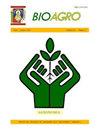洛哈省5个番茄新品种(Solanum lycopersicum L.)对两种病虫害防治的农艺性能评价
IF 0.7
4区 农林科学
Q4 AGRONOMY
引用次数: 0
摘要
番茄是消费量最大的蔬菜之一,大量的病虫害问题限制了番茄的生产。本研究有两个目的:第一,描述了五个不同番茄群体的形态特征;第二,在对作物常见病虫害进行化学或生物防治时,对候选品种基因型的产量反应进行了评估。种群表现出独特的形态特征、果实硬度、大小和形状。试验结果表明,品种间和品种间的交互作用存在显著差异。对照品种的产量最低(28630 kg·ha-1),特别是2号品种(66090 kg·ha-2)。品种2(樱桃大小的果实)和品种3(大尺寸的果实)由于产量高,应考虑进行大规模栽培。品种2和3对这两种农药都有充分的反应,在化学控制下具有产量优势。尽管如此,与厄瓜多尔目前在传统番茄种植中使用的大量应用相比,化学产品的使用量很小(3-4次就足够了)。本文章由计算机程序翻译,如有差异,请以英文原文为准。
Evaluation of the agronomical performance of five new tomato varieties (Solanum lycopersicum L.) against two pest and disease control treatments in the province of Loja
Tomato is one of the most consumed vegetables, with abundant pests and diseases problems limiting its production. This research had two objectives: in the first one, the morphological characteristics of five different tomato populations, were described; in the second, the yield response of candidate-to-be varieties genotypes was evaluated when submitted to chemical or biological control of pest and diseases that commonly attack the crop. The populations showed distinctive morphological characteristics, fruit firmness, size, and shape. The experimental test results indicated significant differences among varieties and in the interaction of variety x method of control. The control variety showed the lowest yield (28,630 kg·ha-1) when compared to the candidate varieties, especially Variety 2 (66,090 kg·ha-1). Variety 2 (cherry-size-fruit) and Variety 3 (large-size-fruit) should be taken into consideration for large-scale cultivation due to their high yield. Varieties 2 and 3 reacted adequately to both kind of pesticides, with an advantage in yield under chemical control. Nonetheless, the use of chemical products was minimal (3-4 applications were enough), as compared to the high number of applications that are currently used under the traditional tomato cultivation in Ecuador.
求助全文
通过发布文献求助,成功后即可免费获取论文全文。
去求助
来源期刊

Bioagro
Agricultural and Biological Sciences-General Agricultural and Biological Sciences
CiteScore
1.40
自引率
37.50%
发文量
22
期刊介绍:
Bioagro es una revista científica del Decanato de Agronomía de la Universidad Centroccidental “Lisandro Alvarado” (UCLA). Su periodicidad es cuatrimestral y se publica en los meses de enero, mayo y septiembre. Cada trabajo es revisado por al menos dos especialistas en el área, externos a la revista, de cuya opinión depende la aceptación definitiva. Se utiliza sistema de arbitraje doble ciego.
La revista va dirigida, fundamental pero no exclusivamente, a profesionales y técnicos del área agrícola. Su objetivo es publicar trabajos científicos originales e inéditos en ciencias agrícolas que enfoquen aspectos de agronomía, botánica y propagación de plantas, entomología y zoología, suelos, fitopatología y protección vegetal, ingeniería agrícola, genética y mejoramiento de plantas, ecología, procesamiento de productos agrícolas, biotecnología y sociales. También pueden ser publicados artículos cortos en los que se presenten descubrimientos científicos, desarrollos tecnológicos y resultados de diagnósticos integrales, en la modalidad de Notas Técnicas.
En Venezuela, se encuentra en las bibliotecas de todas las universidades e institutos de educación superior que ofrecen carreras agronómicas, así como de los entes oficiales de investigación agropecuaria. En el exterior, la revista llega a universidades y/o institutos de investigación agrícolas de todos los países de América Latina así como Estados Unidos, Canadá y España.
 求助内容:
求助内容: 应助结果提醒方式:
应助结果提醒方式:


